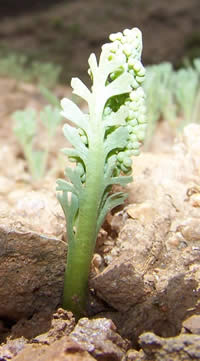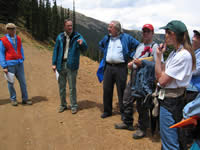Conserving Forkleaved Moonwort in the High Mountains of Colorado
 Forkleaved moonwort (Botrychium furcatum Farrar in ed.), a new plant found in Colorado. Plant height is 1-2 inches (2.5-5 cm). Photo by K. Sevier, USDA Forest Service.
Forkleaved moonwort (Botrychium furcatum Farrar in ed.), a new plant found in Colorado. Plant height is 1-2 inches (2.5-5 cm). Photo by K. Sevier, USDA Forest Service.
 Jim Kerrigan (left), Design Engineer with Federal Highway Administration, and Steve Popovich (2nd from right), Forest Service Botanist, discuss re-route alternatives at site of the Guanella Pass moonworts. Photo by A. Kratz, USDA Forest Service.
Jim Kerrigan (left), Design Engineer with Federal Highway Administration, and Steve Popovich (2nd from right), Forest Service Botanist, discuss re-route alternatives at site of the Guanella Pass moonworts. Photo by A. Kratz, USDA Forest Service.
 Forest Service Botanist Steve Popovich (center) discusses re-route alternatives with Federal Highway Administration biologists Bob Nestel (left) and Jennifer Corwin (right) at site of the Guanella Pass moonworts. Photo by A. Kratz, USDA Forest Service.
Forest Service Botanist Steve Popovich (center) discusses re-route alternatives with Federal Highway Administration biologists Bob Nestel (left) and Jennifer Corwin (right) at site of the Guanella Pass moonworts. Photo by A. Kratz, USDA Forest Service.
by Steve Popovich
A new kind of moonwort (Botrychium furcatum), a small primitive plant related to ferns, was discovered in summer 2005 in the high mountains west of Denver, Colorado. A half dozen individuals were noticed by a wildlife biologist while conducting last-minute field surveys for rare plants prior to reconstruction of a scenic road popular with tourists and locals. Dr. Don Farrar, a moonwort expert at Iowa State University, analyzed proteins in the plants. Results indicated that they are an entity new to science. At this time, they are known in the world only from the Guanella Pass area near Denver and two other places in Colorado. All are on National Forest land, but searches continue in hopes of finding new plants across the West.
About half of the moonwort plants occur in an area that was to be obliterated for the road improvements. They were found only a day before work was to affect the area. The Arapaho National Forest and the Federal Highway Administration held an emergency meeting to determine the best way to address the unusual plants. Steve Popovich, Forest Botanist, and Dan Lovato, Clear Creek District Ranger hosted the meeting. The road was rerouted to avoid disturbing the site at considerable cost overrun and a challenging redesign in a steep valley.
"We are happy that Federal Highways is taking a pro-active approach to conservation of the plants," said Jim Bedwell, former Arapaho and Roosevelt National Forests Supervisor. "We worked together closely to reach a solution. The road improvement project will continue, and the rare plants will be protected. It's a win-win. This is a good example of cooperation between agencies resulting in meeting the goals of both." "We are seeing things at Guanella Pass that just don't show up at other moonwort sites," Dr. Farrar said. "The process of combining DNA from differing lineages of parents that may be occurring here is one way that organisms can become new species," he said.
Popovich added, “We are not only preserving the site, but we are preserving an important evolutionary process that may be key to understanding how this primitive plant group evolves. That makes their protection a very worthwhile endeavor."
The U.S. Fish and Wildlife Service has taken an interest in this plant for possible future listing as Threatened or Endangered, because there are only about 30 plants known in the world. Two of the three sites where it occurs are not secure from threats caused by human activities.
For More Information
Steve J. Popovich, Forest Botanist USDA Forest Service Arapaho-Roosevelt National Forest Fort Collins, Colorado 970-295-6641

